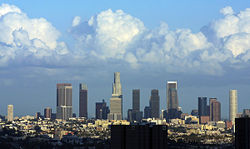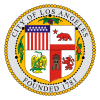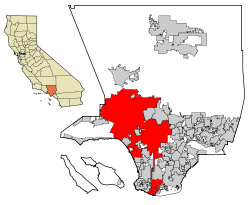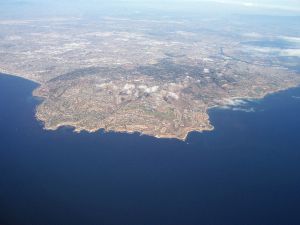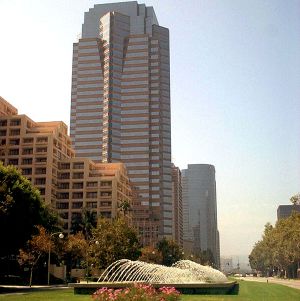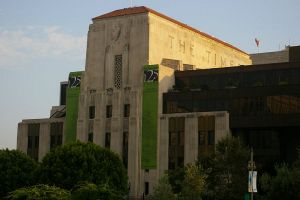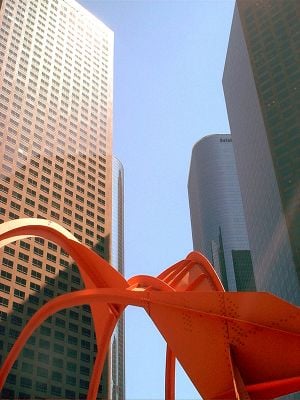Difference between revisions of "Los Angeles, California" - New World Encyclopedia
Vicki Phelps (talk | contribs) |
Vicki Phelps (talk | contribs) |
||
| Line 138: | Line 138: | ||
==Culture== | ==Culture== | ||
| − | [[Image:Disneyconcerthall.jpg|right|thumb|The | + | [[Image:Disneyconcerthall.jpg|right|thumb|The Walt Disney Concert Hall, designed by award-winning architect Frank Gehry, is home to the Los Angeles Philharmonic.]] |
| − | |||
| − | |||
| − | |||
| − | |||
| − | |||
| − | |||
===Sports=== | ===Sports=== | ||
| − | + | Los Angeles is the home of the Los Angeles Dodgers of [[Major League Baseball]], the Los Angeles Kings of the [[National Hockey League]], and the Los Angeles Lakers of the [[National Basketball Association]]. Los Angeles is also home to the USC Trojans and the UCLA Bruins in the NCAA, both of which are Division I teams in the Pacific 10 Conference. UCLA has more NCAA national championships, all sports combined, than any other university in America. USC has the third most NCAA national championships, all sports combined, in the United States. | |
| − | Los Angeles is the home of the | ||
| − | |||
| − | |||
| − | + | [[Image:Dodger Stadium.jpg|right|thumb|Dodger Stadium is the home of the Los Angeles Dodgers.]] | |
| − | |||
| − | Los Angeles has twice played host to the summer [[Olympic | + | Los Angeles has twice played host to the summer [[Olympic games]], in 1932 and in 1984. Super Bowls I and VII were also held in the city, as well as soccer's international [[FIFA World Cup|World Cup]] in 1994. |
| − | [[Beach volleyball]] and [[windsurfing]] were both invented in the area | + | [[Beach volleyball]] and [[windsurfing]] were both invented in the area. |
| − | [[Image:Staples-centerLA.jpg|right|thumb| | + | [[Image:Staples-centerLA.jpg|right|thumb|Staples Center, a premier venue for sports and entertainment, is home to five professional sports teams.]] |
| − | The Los Angeles area contains varied [[topography]], notably the [[hill]]s and [[mountain]]s rising around the | + | The Los Angeles area contains varied [[topography]], notably the [[hill]]s and [[mountain]]s rising around the metropolis, making Los Angeles the only major city in the United States bisected by a mountain range; four mountain ranges extend into city boundaries. Thousands of miles of trails crisscross the city and neighboring areas, providing opportunities for [[exercise]] and [[wilderness]] access on [[hiking|foot]], [[Mountain biking|bike]], or [[horse]]. Across the county a great variety of outdoor activities are available, such as [[skiing]], [[rock climbing]], [[gold]] panning, [[hang gliding]], and [[windsurfing]]. |
| − | |||
| − | |||
| + | Los Angeles boasts a number of sports venues, including the Staples Center, a sports and entertainment complex that also hosts concerts and awards shows such as the Grammys. | ||
===Media=== | ===Media=== | ||
| − | [[Image:Foxyplaza.jpg|thumb| | + | [[Image:Foxyplaza.jpg|thumb|Fox Plaza, headquarters for 20th Century Fox, in Century City, a major financial district for West Los Angeles.]] |
| − | The major daily newspaper in the area is '' | + | The major daily newspaper in the area is the ''Los Angeles Times''; ''La Opinión'' is the city's major Spanish language-language paper. |
| − | + | The Los Angeles metropolitan area is served by a variety of local television stations and is the second-largest media market in North America (behind [[New York City]]. | |
| − | |||
| − | The Los Angeles metropolitan area is served by a variety of local television stations and is the second-largest media market in North America (behind [[New York City]]. | ||
| − | |||
| − | |||
[[Image:Latimeshq.JPG|thumb|Los Angeles Times Headquarters]] | [[Image:Latimeshq.JPG|thumb|Los Angeles Times Headquarters]] | ||
| − | |||
| − | |||
| − | |||
| − | |||
===Religion=== | ===Religion=== | ||
| − | Los Angeles is home to adherents of many religions, with [[Roman | + | Los Angeles is home to adherents of many religions, with [[Roman Catholic]]ism being the largest due to the high numbers of [[Latino]]s. The Roman Catholic Archbishop of Los Angeles leads the largest archdiocese in the country. |
| − | + | [[Image:Los Angeles Temple 1.jpg|thumb|right|Built in 1956, the Los Angeles Temple of The Church of Jesus Christ of Latter-day Saints is the second largest Mormon temple in the world.]] | |
| − | [[ | + | With 621,000 [[Jews]] in the metropolitan area (490,000 in city proper), the region has the second largest population of Jews in the United States.<ref>{{cite web|url=http://www.adherents.com/largecom/com_judaism.html|title=The Largest Jewish Communities|accessdate=2007-08-13}}</ref> |
| − | The Los Angeles | + | The Azusa Street Revival (1906–1909) in Los Angeles was a key milestone in the history of the [[Pentecostal]] movement, not long after Christian [[Fundamentalism]] received its name and crucial promotion in Los Angeles. In 1909, the Bible Institute of Los Angeles published and widely distributed a set of books called ''The Fundamentals'', which presented a defense of the traditional conservative interpretation of the [[Bible]]. The term ''fundamentalism'' is derived from these books. Los Angeles is also a major hub of the [[House Church]] Movement. Dr. Gabe Veas is one of the leaders of this group, pastoring the house church network known as Authentic LA. |
| − | + | [[Image:Lacathedral.jpg|thumb|right|The Cathedral of Our Lady of the Angels is the mother church of the Roman Catholic Archdiocese of Los Angeles.]] | |
| − | + | In the 1920s, [[Aimee Semple McPherson]] established a thriving evangelical ministry, with her Angelus Temple in Echo Park open to both black and white church members of the [[International Church of the Foursquare Gospel|Foursquare Church]]. [[Billy Graham]] became a celebrity during a successful revival campaign in Los Angeles in 1949. | |
| − | [[Image: | + | [[Image:Rukmini-Dwarakadisa.jpg|thumb|Altar deities at a Hindu temple in Los Angeles, devoted to the god, [[Krishna]]]] |
| − | + | Because of Los Angeles' large multi-ethnic population, there are numerous organizations in the area representing a wide variety of faiths, including [[Islam]], [[Buddhism]], [[Hinduism]], [[Zoroastrianism]], [[Sikhism]], [[Bahá'í Faith|Bahá'í]], various [[Eastern Orthodox Church]]es, [[Sufism]], and others. Immigrants from [[Asia]], for example, have formed a number of significant Buddhist congregations, making the city home to the biggest variety of Buddhists in the world. Los Angeles currently has the largest Buddhist population in the [[United States]]. There are over 300 temples in Los Angeles. | |
| − | + | Los Angeles has been a destination for [[swami]]s and [[guru]]s since as early as 1900, including [[Paramahansa Yogananda]] (1920). The [[Self-Realization Fellowship]] is headquartered in Hollywood. Los Angeles is the home to a number of [[Neopaganism|Neopagan]]s, as well as adherents of various other mystical religions. One wing of the [[Theosophist]] movement is centered in Los Angeles, and another is in neighboring Pasadena. [[Maharishi Mahesh Yogi]], considered a spiritual, rather than a religious leader, founded the [[Transcendental Meditation]] movement in Los Angeles in the late 1950s. The [[Kabbalah]] Centre is in the city. The [[Church of Scientology]] has had a presence in Los Angeles since 1954. | |
| − | |||
==Economy== | ==Economy== | ||
Revision as of 02:33, 30 November 2008
| City of Los Angeles | |||
|
|||
| Nickname: The City of Angels, L.A. | |||
| Location within Los Angeles County in the state of California | |||
| Coordinates: 34°03′N 118°15′W | |||
|---|---|---|---|
| State | California | ||
| County | Los Angeles County | ||
| Settled | 1781 | ||
| Incorporated | April 4 1850 | ||
| Government | |||
| - Type | Mayor-Council | ||
| - Mayor | Antonio Villaraigosa | ||
| - City Attorney | Rocky Delgadillo | ||
| - Governing body | City Council | ||
| Area | |||
| - City | 498.3 sq mi (1,290.6 km²) | ||
| - Land | 469.1 sq mi (1,214.9 km²) | ||
| - Water | 29.2 sq mi (75.7 km²) 5.8% | ||
| - Urban | 1,667.9 sq mi (4,319.9 km²) | ||
| Elevation | 0–5,079 ft (0–1,548 m) | ||
| Population (2006) | |||
| - City | 3,849,368 | ||
| - Density | 8,205/sq mi (3,168/km²) | ||
| - Metro | 12,950,119 | ||
| - Demonym | Angeleno | ||
| Time zone | PST (UTC-8) | ||
| - Summer (DST) | PDT (UTC-7) | ||
| Website: www.ci.la.ca.us/ | |||
Los Angeles is the largest city in the state of California and the second-largest in the United States. Often abbreviated as L.A., it had an estimated population in 2006 of 3.8 million.[1] Additionally, the Greater Los Angeles Area metropolitan area is home to nearly 13 million people who hail from all over the globe. They speak more than a hundred different languages.[2] Los Angeles is the county seat of Los Angeles County, California, the most populous county in the United States. Its inhabitants call themselves "Angelenos." The city's most popular nickname is "City of Angels."
Los Angeles and California became part of the United States at the end of the Mexican-American War in 1848.
Los Angeles is today one of the world's most prominent centers of culture, technology, and international trade. It is home to world-renowned institutions covering a broad range of professional and cultural fields. The city and its immediate vicinity lead the world in producing popular entertainment—such as motion picture, television, and recorded music—which forms the base of Los Angeles' international fame and global status.
Geography
Topography
Los Angeles has a total area of 498.3 square miles (1,290.6 km²), making it the 14th largest city in land area in the United States.[3]
The highest point in Los Angeles is Mount Lukens. Located at the far reaches of the northeastern San Fernando Valley, it reaches a height of 5,080 feet (1,548 m). The major river is the Los Angeles River, which is largely seasonal. The river is lined in concrete for almost its entire length as it flows through the city on its way to the Pacific Ocean.
Geology
Los Angeles is subject to earthquakes due to its location in the Pacific Ring of Fire. The geologic instability produces numerous fault lines both above and below ground, which altogether cause approximately 10,000 earthquakes every year.[4] One of the major fault lines is the San Andreas Fault. Located at the boundary between the Pacific Plate and the North American Plate, it is predicted to be the source of Southern California's next big earthquake. Parts of the city are also vulnerable to Pacific Ocean tsunamis.
Climate
The city is situated in a Mediterranean climate, experiencing mild, somewhat wet winters and warm to hot summers. Breezes from the Pacific Ocean tend to keep the beach communities of the Los Angeles area cooler in summer and warmer in winter than those further inland. Coastal areas also see a phenomenon known as the "marine layer," a dense cloud cover caused by the proximity of the ocean that helps keep the temperatures cooler throughout the year.
Temperatures in the summer can get well over 90°F (32°C), but average summer daytime highs in downtown are 82°F (27°C). Winter daytime high temperatures average 65°F (18°C), and during this season rain is common. The warmest month is August, followed by July and then September.
The highest temperature recorded for Downtown Los Angeles was 112.0°F (44.4°C) on June 26, 1990, and the lowest temperature recorded was 24.0°F (−5.0°C) on January 9, 1937.
Rain occurs mainly in the winter and spring months (February being the wettest month), with great annual variations in storm severity. Los Angeles averages 15 inches (38 cm) of precipitation per year. Snow is rare in the city basin, but the mountainous slopes within city limits typically receive snow every year.
Flora
The Los Angeles area is rich in native plant species due in part to a diversity in habitats, including beaches, wetlands, and mountains. The most prevalent botanical environment is coastal sage scrub, which covers the hillsides in combustible California chaparral and woodlands. Native plants include: California poppy, matilija poppy, toyon, coast live oak, and giant wild rye grass. Many of these native species, such as the Los Angeles sunflower, have become so rare as to be considered endangered. Though they are not native to the area, the official tree of Los Angeles is the tropical Coral Tree and the official flower is the Bird of Paradise.
Cityscape
The city is divided into many neighborhoods, many of which were towns that were annexed by the growing city. There are also several independent cities in and around Los Angeles, but they are popularly grouped with the city of Los Angeles, either due to being completely engulfed as enclaves by Los Angeles, or lying within its immediate vicinity. Generally, the city is divided into the following areas: Downtown Los Angeles, the East Los Angeles (region)|Eastside, South Los Angeles, the Harbor Area, Hollywood, Los Angeles, California, Wilshire, Los Angeles, California, the West Los Angeles (region), and the San Fernando Valley
Some well-known communities of Los Angeles include Watts, Venice, Los Angeles, California, the Financial District, Los Angeles, California, Los Feliz, Los Angeles, California, Silver Lake, Los Angeles, California, Hollywood, Los Angeles, California, Hancock Park, Los Angeles, California, Koreatown, Los Angeles, California, Westwood, Los Angeles, California and the more affluent areas of Bel-Air, Benedict Canyon, Hollywood Hills, Pacific Palisades, Los Angeles, California, and Brentwood, Los Angeles, California.
Landmarks
Important landmarks in Los Angeles include Chinatown, Los Angeles, California, Koreatown, Little Tokyo, Disney Concert Hall, Kodak Theater, Griffith Observatory, Getty Center, Los Angeles Memorial Coliseum, Los Angeles County Museum of Art, Grauman's Chinese Theater, Hollywood sign, Hollywood Boulevard, Capitol Records Tower, Los Angeles City Hall, Hollywood Bowl, Watts Towers, Staples Center, Dodger Stadium and Mission Nuestra Señora Reina de los Angeles|La Placita Olvera.
- WaltDisneyConcertHall.jpeg
Walt Disney Concert Hall
- Staplescenter.jpg
Staples Center
- LA Library.jpg
Los Angeles Central Library
History
The Los Angeles coastal area was first settled by the Tongva (or Gabrieleños) and Chumash (tribe) Native American tribes thousands of years ago. The first Europeans arrived in 1542 under Juan Rodríguez Cabrillo|Joao Cabrilho, a Portuguese explorer who claimed the area as the City of God for the Spanish Empire but continued with his voyage and did not establish a settlement.[5] The next contact would not come until 227 years later when Gaspar de Portolà, together with Franciscan missionary Juan Crespi, reached the present site of Los Angeles on August 2 1769. Crespi noted that the site had the potential to be developed into a large settlement.[6]
In 1771, Franciscan friar Junipero Serra built the Mission San Gabriel Arcangel near Whittier Narrows, in what is now called San Gabriel Valley.[7] In 1777, the new governor of California, Felipe de Neve, recommended to the viceroy of New Spain that the site recommended by Juan Crespi be developed into a pueblo. The town was founded on September 4, 1781 by a group of 44 settlers and was named "El Pueblo de Blessed Virgin Mary|Nuestra Señora la Reina de los Ángeles del Río de Porciúncula," ("The Town of Our Lady the Queen of the Angels on the River Porciúncula").[8] These settlers were of Filipino, Native American, African, and Spanish ancestry, with two-thirds being mestizo or mulatto. A majority of the settlers had some African ancestry.[9] The settlement remained a small ranch town for decades, but by 1820 the population had increased to about 650 residents.[10] Today, the pueblo is commemorated in the historic district Olvera Street, the oldest part of Los Angeles.[11]
New Spain achieved its independence from the Spanish Empire in 1821, and the pueblo continued as a part of Mexico. Mexican rule ended during the Mexican-American War, when Americans took control from the Californios after a series of battles, culminating in the signing of the Treaty of Cahuenga on January 13, 1847. Later, with the Treaty of Guadalupe Hidalgo in 1848, the Mexican government formally ceded Alta California and other territories to the United States.
Railroads arrived when the Southern Pacific completed its line to Los Angeles in 1876.[12] Oil was discovered in 1892, and by 1923 Los Angeles was producing one-quarter of the world's petroleum.[13]
By 1900, the population had grown to more than 100,000 people [14], which began to put pressure on the city's water supply.[15] The 1913 completion of the Los Angeles aqueduct under the supervision of William Mulholland, assured the continued growth of the city. In 1915, Los Angeles began annexation of dozens of neighboring communities without water supplies of their own.
In the 1920s, the motion picture and aviation industries flocked to Los Angeles. In 1932, with population surpassing one million[16], the city hosted the Summer Olympics. This period also saw the arrival of exiles from the increasing pre-war tension in Europe, including Thomas Mann, Fritz Lang, Bertolt Brecht, Arnold Schoenberg, and Lion Feuchtwanger.
World War II and the expansion of defense industries brought new growth and prosperity to the city. Thousands of African Americans migrated from Texas, Louisiana and Mississippi to work in the expanding industries. Shamefully, the state succumbed to war fears and transported most Japanese-American residents from Los Angeles and other cities to distant internment camps for the duration of the war.
The post-war years saw an even greater boom as urban sprawl expanded the city into the San Fernando Valley.[17]In 1969, Los Angeles became one of the birthplaces of the Internet, as the first ARPANET transmission was sent from UCLA to SRI International in Menlo Park, California.[18]
As in other major cities, long-unresolved racial problems erupted in the 1960s and 1970s. Los Angeles grappled with the Watts riots in 1965, the high school walkout by Chicano students in 1968, and the 1970 Chicano Moratorium, as representative of racial strife within the city.
In 1984, the city hosted the Summer Olympics 1984 Summer Olympics for the second time. The rest of the 1980s was plagued by an increase in gang violence, when crack cocaine became wildly available, and police corruption. Racial tensions surfaced again in 1991 with the Rodney King controversy and the large-scale riots that followed the acquittal of his attackers. In 1994, the Northridge earthquake shook the city and caused 72 deaths.[19]
Despite propositions by San Fernando Valley and Hollywood sections to secede from the city in 2002, residents voted down secession.[20] The 2000s has seen a rise in urban redevelopment and gentrification in various parts of the city, most notably Echo Park, Los Angeles, California|Echo Park and Downtown Los Angeles.[21]
Culture
Sports
Los Angeles is the home of the Los Angeles Dodgers of Major League Baseball, the Los Angeles Kings of the National Hockey League, and the Los Angeles Lakers of the National Basketball Association. Los Angeles is also home to the USC Trojans and the UCLA Bruins in the NCAA, both of which are Division I teams in the Pacific 10 Conference. UCLA has more NCAA national championships, all sports combined, than any other university in America. USC has the third most NCAA national championships, all sports combined, in the United States.
Los Angeles has twice played host to the summer Olympic games, in 1932 and in 1984. Super Bowls I and VII were also held in the city, as well as soccer's international World Cup in 1994.
Beach volleyball and windsurfing were both invented in the area.
The Los Angeles area contains varied topography, notably the hills and mountains rising around the metropolis, making Los Angeles the only major city in the United States bisected by a mountain range; four mountain ranges extend into city boundaries. Thousands of miles of trails crisscross the city and neighboring areas, providing opportunities for exercise and wilderness access on foot, bike, or horse. Across the county a great variety of outdoor activities are available, such as skiing, rock climbing, gold panning, hang gliding, and windsurfing.
Los Angeles boasts a number of sports venues, including the Staples Center, a sports and entertainment complex that also hosts concerts and awards shows such as the Grammys.
Media
The major daily newspaper in the area is the Los Angeles Times; La Opinión is the city's major Spanish language-language paper.
The Los Angeles metropolitan area is served by a variety of local television stations and is the second-largest media market in North America (behind New York City.
Religion
Los Angeles is home to adherents of many religions, with Roman Catholicism being the largest due to the high numbers of Latinos. The Roman Catholic Archbishop of Los Angeles leads the largest archdiocese in the country.
With 621,000 Jews in the metropolitan area (490,000 in city proper), the region has the second largest population of Jews in the United States.[22]
The Azusa Street Revival (1906–1909) in Los Angeles was a key milestone in the history of the Pentecostal movement, not long after Christian Fundamentalism received its name and crucial promotion in Los Angeles. In 1909, the Bible Institute of Los Angeles published and widely distributed a set of books called The Fundamentals, which presented a defense of the traditional conservative interpretation of the Bible. The term fundamentalism is derived from these books. Los Angeles is also a major hub of the House Church Movement. Dr. Gabe Veas is one of the leaders of this group, pastoring the house church network known as Authentic LA.
In the 1920s, Aimee Semple McPherson established a thriving evangelical ministry, with her Angelus Temple in Echo Park open to both black and white church members of the Foursquare Church. Billy Graham became a celebrity during a successful revival campaign in Los Angeles in 1949.
Because of Los Angeles' large multi-ethnic population, there are numerous organizations in the area representing a wide variety of faiths, including Islam, Buddhism, Hinduism, Zoroastrianism, Sikhism, Bahá'í, various Eastern Orthodox Churches, Sufism, and others. Immigrants from Asia, for example, have formed a number of significant Buddhist congregations, making the city home to the biggest variety of Buddhists in the world. Los Angeles currently has the largest Buddhist population in the United States. There are over 300 temples in Los Angeles.
Los Angeles has been a destination for swamis and gurus since as early as 1900, including Paramahansa Yogananda (1920). The Self-Realization Fellowship is headquartered in Hollywood. Los Angeles is the home to a number of Neopagans, as well as adherents of various other mystical religions. One wing of the Theosophist movement is centered in Los Angeles, and another is in neighboring Pasadena. Maharishi Mahesh Yogi, considered a spiritual, rather than a religious leader, founded the Transcendental Meditation movement in Los Angeles in the late 1950s. The Kabbalah Centre is in the city. The Church of Scientology has had a presence in Los Angeles since 1954.
Economy
- Further information: Los Angeles County Economy
The economy of Los Angeles is driven by international trade, entertainment (television, motion pictures, recorded music), aerospace, technology, petroleum, fashion, apparel, and tourism. Los Angeles is also the largest manufacturing center in the United States.[23] The contiguous ports of Los Angeles and Long Beach together comprise the most significant port in North America and one of the most important ports in the world, and they are vital to trade within the Pacific Rim.[23] Other significant industries include media production, finance, telecommunications, law, health and medicine, and transportation.
For many years, up until the mid-1990s, Los Angeles was home to many major financial institutions in the western United States, including First Interstate Bank (disambiguation), which merged with Wells-Fargo in 1996, Great Western Bank, merged with Washington Mutual in 1998, and Security Pacific National Bank, which merged with Bank of America in 1992. Los Angeles was also home to the Pacific Stock Exchange until it closed in 2001.
The city is home to five major Fortune 500 companies, including aerospace contractor Northrop Grumman, energy company Occidental Petroleum, healthcare provider Health Net, homebuilding company KB Home, and metals distributor Reliance Steel & Aluminum. The University of Southern California (USC) is the city's largest private sector employer.[24]
), ICANN (Marina Del Rey, California), Cunard Line (Santa Clarita, California), Princess Cruises (Santa Clarita), Activision (Santa Monica, California), and RAND (Santa Monica). The L.A. area is also home to the U.S. headquarters of all but two of the major Asian automobile manufacturers. Further, virtually all the world's automakers have design and/or tech centers in the L.A. region. Downtown Los Angeles also is the home of the Los Angeles Convention Center which hosts many popular events.
Demographics
2000 census
As of the 2000 census, there were 3,694,820 people, 1,275,412 households, and 798,407 families residing in the city. The population density was 7,876.8 people per square mile (3,041.3/km²). There were 1,337,706 housing units at an average density of 2,851.8 per square mile (1,101.1/km²).
Los Angeles is home to people from more than 140 countries speaking 224 different languages.
The racial makeup of the city in 2000 was 46.9% white (29.7% white/non-Latino), 11.24% African American, 10.0% Asian, 0.8% Native American, 0.16% Pacific Islander, 25.9% from other races, and 5.2% from two or more races. Nearly half (46.5%) of the population were Hispanic or Latino (of any race). Languages spoken include English, 42.2%; Spanish, 41.7%; Korean, 2.4%; Tagalog, 2.3%; Armenian, 1.7%; Chinese (including Cantonese and Mandarin), 1.5%; and Persian, 1.3% as their first language. Since the mid-80s Los Angeles has been a minority-majority city.
According to the census, 33.5% of households had children under 18, 41.9% were married couples, 14.5% had a female householder with no husband present, and 37.4% were non-families. 28.5% of households were made up of individuals and 7.4% had someone living alone who was 65 years of age or older. The average household size was 2.83 and the average family size 3.56.

The age distribution was: 26.6% under 18, 11.1% from 18 to 24, 34.1% from 25 to 44, 18.6% from 45 to 64, and 9.7% who were 65 or older.
The median income for a household was $36,687, and for a family was $39,942. Males had a median income of $31,880, females $30,197. The per capita income was $20,671. 22.1% of the population and 18.3% of families were below the poverty line. 30.3% of those under the age of 18 and 12.6% of those aged 65 or older were below the poverty line.
While many other American cities have experienced central area population declines, the opposite was true in Los Angeles, due in part to the city's large immigrant population.
In the period from 1920 to 1960, African Americans from the Southeast arrived in Los Angeles, swelling its population by 15 times. Since 1990, the African-American population has dropped as its middle class relocated to the suburbs. Latinos have moved into the once predominantly African-American district of South Los Angeles. African Americans still remain predominant in some portions of the city.
Of 1,512,720 foreign-born people who lived in the city in 2000, 100,252 were born in Europe, 376,767 were born in Asia, 64,730 were born in Africa, 94,104 were born in Caribbean/Oceania, 996,996 were born in Latin America, and 13,859 were born in Canada.
By the next national census, Los Angeles is expected to have a Latino majority for the first time since 1850. The Latino, Asian American, and Caribbean populations are growing particularly quickly—the Asian-American population is the largest of any U.S. city. Los Angeles hosts large populations of Cambodians, Iranians, Armenians, Belizeans, Bulgarians, Ethiopians, Filipinos, Guatemalans, Hungarians, Indians, Koreans, Israelis, Mexicans, Pakistanis, Salvadorans, Thais, and Pacific Islanders such as Samoans. Los Angeles is also home to the largest populations of Japanese living in the United States, and has one of the largest Native American populations in the country. The metropolitan area also is home to the second largest concentration of people of Jewish descent (estimated at 621,000) in the Americas, after New York City. Los Angeles also has the second largest Nicaraguan community in the United States after Miami. Los Angeles experienced minor waves of European immigration in the late 1800s and early 1900s and the city has sizable populations of German, Greek, Irish, Italian, Romanian, Romani, Polish, Portuguese, Serb, Spanish, Lebanese, Croatian, and Ukrainian descent.
Government
The city is governed by a mayor-council system. The current mayor is Antonio Villaraigosa. There are 15 city council districts. Other elected city officials include the city attorney, who prosecutes misdemeanors within the city limits, and the city controller.
The city government has been perceived as inefficient and ineffective by residents of some areas, which led to an unsuccessful secession effort by the San Fernando Valley and Hollywood in 2002. The campaign to defeat secession was led by then Mayor James Hahn. The most common complaint is that the city administration in Downtown gives priority to high-density neighborhoods like Mid-City and Downtown at the expense of its far-flung suburban neighborhoods.
As the city does not have officially named districts, most areas and neighborhoods are known either by the names given by tract developers when first developed, or by the names of principal neighborhood streets, or by the names of the formerly independent communities that were annexed by the city.[citation needed]
Neighborhood councils
Voters created neighborhood councils in the Charter Reform of 1999. They were designed to promote public participation in government and make it more responsive to local needs. The councils cover districts, which are not necessarily identical to the traditional neighborhoods of Los Angeles.
Almost ninety neighborhood councils (NCs) are certified and all "stakeholders"—meaning anyone who lives, works, or owns property in a neighborhood—may vote for members of the councils' governing bodies.
The first notable concern of the neighborhood councils collectively was the opposition by some of them in March 2004 to an 18 percent increase in water rates by the city's Department of Water and Power. This led the City Council to approve only a limited increase pending independent review. The neighborhood councils have been allocated $50,000 each for administration, outreach, and approved neighborhood projects.
Crime
Los Angeles has been experiencing significant decline in Part I offenses since the mid-1990s, and hit a record low in 2006, with 29,737 acts of violence, of which 481 were homicides. The distribution of homicides in the city is uneven, with nearly half occurring in South Los Angeles and the Harbor area. Another quarter occur Downtown and its environs. Property crimes were over three times more common than violent crimes; 102,297 were recorded in 2006.
According to a May 2001 Drug Threat Assessment by the National Drug Intelligence Center, Los Angeles County is home to 152,000 gang members organized into 1,350 gangs.[27] Among the most infamous are the Crips, Bloods, 18th Street gang, Florencia 13, and MS-13 (Mara Salvatrucha). This has led to the city being referred to as the "Gang Capital of America." Car chases happen more often than in most other major cities, with the city's complex freeway system allowing for lengthier pursuits. Other automobile-oriented crimes include car-to-car shootings, drive-by shootings, freeway shootings, hit and run accidents, and carjackings.
Education
Elementary and secondary schools
Los Angeles Unified School District (LAUSD) serves most of the city of Los Angeles, as well as several surrounding communities, with a student population of over 800,000.[28] LAUSD is the second largest school district in the United States; only the New York City Department of Education is larger.
After Proposition 13 was approved in 1978, urban school districts had considerable trouble with funding. LAUSD has become known for its underfunded, overcrowded, and poorly maintained campuses, although its 162 magnet schools help compete with local private schools.
Colleges and universities
There are three public universities located within the city limits—California State University, Los Angeles; California State University, Northridge; and University of California, Los Angeles (UCLA)—as well as a number of private colleges. The community college system consists of nine campuses.
- CSULA 002.jpg
CSULA - Csun-mc.jpg
CSUN - Bluff25.jpg
LMU - Johnson Student Center and Freeman College Union.jpg
Occidental College
Transportation
Los Angeles has 27 intertwining freeways handling millions of commuters on a daily basis. Los Angeles is the most car-populated metropolis in the world with 1 registered automobile for every 1.8 people.
Rail Transportation
The Los Angeles County Metropolitan Transportation Authority and other agencies operate an extensive system of bus lines, as well as subway and light rail lines. Los Angeles' mass transit system does not have high per capita ridership, with 10.5 percent of commuters using public transit,[29] compared with 53 percent and 30 percent in New York and Chicago, respectively.
Air Transportation
The Los Angeles metropolitan area is served by more airports than any other city in the world.[30] There are six commercial airports and many more general-aviation airports. The main Los Angeles airport is Los Angeles International Airport. The fifth busiest commercial airport in the world and the third busiest in the United States, LAX handled over 61 million passengers and 2 million tons of cargo in 2006.[31]
Harbors
The Port of Los Angeles is located in San Pedro Bay, approximately 20 miles (30 km) south of Downtown Los Angeles. The port complex occupies 7,500 acres (30 km²) of land and water along 43 miles (69 km) of waterfront. It adjoins the separate Port of Long Beach.
Looking to the future
Environmental issues
Due to geography, heavy reliance on automobiles, and the Los Angeles/Long Beach port complex, Los Angeles suffers from air pollution in the form of smog. The Los Angeles Basin and the San Fernando Valley are susceptible to atmospheric inversion, which holds in the exhausts from road vehicles, airplanes, locomotives, shipping, manufacturing, and other sources.
Unlike other large cities that rely on rain to clear smog, Los Angeles gets only 15 inches (381 mm) of rain each year. Pollution accumulates over multiple consecutive days. Issues of air quality in Los Angeles and other major cities led to the passage of early national environmental legislation, including the Clean Air Act. More recently, the state of California has led the nation in working to limit pollution by mandating low emissions vehicles.
As a result, pollution levels have dropped in recent decades. The number of Stage 1 smog alerts has declined from over 100 per year in the 1970s to almost zero in the new millennium. Despite improvement, the 2006 annual report of the American Lung Association ranks the city as the most polluted in the country with short-term particle pollution and year-round particle pollution.
In addition, the groundwater is increasingly threatened by MTBE from gas stations and perchlorate from rocket fuel. Methyl tert-butyl ether, also known as MTBE, is used as a gasoline additive as an oxygenate and to raise the octane number. Although its use has declined in the United States in response to environmental and health concerns, it has been found to easily pollute large quantities of groundwater when gasoline with MTBE is spilled or leaked at gas stations.
With pollution still a significant problem, the city continues to take steps to improve air and water conditions.
Notes
- ↑ U.S Census Bureau Estimates for Incorporated Places over 100,000
- ↑ U.S. Census Bureau Estimates for Metropolitan Statistical Areas
- ↑ Top 100 Cities with Largest Land Area
- ↑ Earthquake Facts
- ↑ Willard, C. D., The Herald's History of Los Angeles (Los Angeles: Kingsley-Barnes, 1901): 22.
- ↑ Father Crespi in Los Angeles
- ↑ After a 1776 flood, the mission was moved to its present site in San Gabriel, California
- ↑ The History of Los Angeles County
- ↑ "Colonial records indicate that twenty-six of the forty-six original settlers of Los Angeles were of African or part-African ancestry." Mulroy, Kevin, et. al, eds, Seeking El Dorado:African Americans in California (Los Angeles: Autry Museum of Western Heritage, 2001): 79.
- ↑ Los Angeles Historical Chronology
- ↑ Acuna, Rodolfo, Anything But Mexican: Chicanos in Contemporary Los Angeles (New York: Version, 1996): 22.
- ↑ Mulholland, Catherine, William Mulholland and the Rise of Los Angeles (Berkeley: University of California Press, 2000): 15.
- ↑ The Story of Oil in California
- ↑ Population of the 100 Largest Urban Places: 1900
- ↑ The Los Angeles Aqueduct and the Owens and Mono Lakes (MONO Case)
- ↑ Population of the 100 Largest Urban Places: 1930
- ↑ Bruegmann, Robert, Sprawl: A Compact History (Chicago: University of Chicago Press, 2005): 133.
- ↑ Was L.A. really Internet's ground zero?
- ↑ Reich, Kenneth, "Study Raises Northridge Quake Death Toll to 72," Los Angeles Times 20 December 1995: B1.
- ↑ City of Los Angeles Secession Votes - 2002
- ↑ Welcome to Gentrification City
- ↑ The Largest Jewish Communities. Retrieved 2007-08-13.
- ↑ 23.0 23.1 City-data.com
- ↑ Evan George, Trojan Dollars: Study Finds USC Worth $4 Billion Annually to L.A. County, Los Angeles Downtown News, December 11, 2006.
- ↑ EVALUATION OF ALTERNATIVES TO THE CITY’S GROSS RECEIPTS BUSINESS TAXUT Strategies, et al. Competitiveness of City Taxes and Fees. 1997.
- ↑ Competitiveness 22.
- ↑ "California Central District Drug Threat Assessment : Overview." National Drug Intelligence Center. May, 2001.
- ↑ http://www.census.gov/hhes/www/saipe/district.html
- ↑ http://www.census.gov/prod/1/gen/pio/cay961a2.pdf
- ↑ http://losangeles225.com/meet.htm
- ↑ LAX Volume of air traffic
ReferencesISBN links support NWE through referral fees
- Banham, Reyner. Los Angeles; the Architecture of Four Ecologies. New York: Harper & Row, 1971. OCLC 140893
- Davis, Mike. City of Quartz Excavating the Future in Los Angeles. London: Verso, 1990. ISBN 9780860913030
- Torin Monahan, Los Angeles Studies: The Emergence of a Specialty Field, City & Society XIV (2): 155-184, 2002
- George, Lynell. No Crystal Stair African-Americans in the City of Angels. London: Verso, 1992. ISBN 9780860913894
- Paul Glover, "Los Angeles: A History of the Future", Eco-Home Press, 1989
- Klein, Norman M. The History of Forgetting Los Angeles and the Erasure of Memory. The Haymarket series. London: Verso, 1997. ISBN 9781859848203
- Pitt, Leonard, and Dale Pitt. Los Angeles A to Z An Encyclopedia of the City and County. Berkeley: University of California Press, 1997. ISBN 9780520202740
- Theroux, Peter. Translating LA A Tour of the Rainbow City. New York: Norton, 1994. ISBN 9780393036473
- Ulin, David L. Writing Los Angeles A Literary Anthology. New York: Library of America, 2002.ISBN 9781931082273
- White, Richard. "It's Your Misfortune and None of My Own" A History of the American West. Norman: University of Oklahoma Press, 1991. ISBN 9780806123660
- Reisner, Marc. Cadillac Desert The American West and Its Disappearing Water. New York, N.Y., U.S.A.: Viking, 1986. ISBN 9780670199273
- Fogelson, Robert M. The Fragmented Metropolis: Los Angeles, 1850-1930. Cambridge: Harvard University Press, 1967. OCLC 480789
- California History, Bancroft
- (other)
External links
All links Retrieved November 23, 2007.
- City of Los Angeles Official Web Site
- LA INC.: Los Angeles Convention & Visitors Bureau
- Los Angeles Convention Center
- Los Angeles Chamber of Commerce
- Los Angeles Police Department
- Los Angeles Public Library - 72 branches
- Los Angeles Almanac
- Los Angeles magazine (print)
- Historic Topographic Maps for Los Angeles County 1920s-1940s (Google Earth Required)
- Los Angeles webcams via Google maps
Maps
-
- Maps from WikiMapia, Google Maps, Live Search Maps, Yahoo! Maps, or MapQuest
- Topographic maps from TopoZone
| ||||||||||
Template:US county navigation box Template:California
| 50 largest cities of the United States by population | |
|---|---|
New York City · Los Angeles · Chicago · Houston · Phoenix · Philadelphia · San Antonio · San Diego · Dallas · San Jose · Detroit · Jacksonville · Indianapolis · San Francisco · Columbus · Austin · Memphis · Fort Worth · Baltimore · Charlotte · El Paso · Boston · Seattle · Washington · Milwaukee · Denver · Louisville · Las Vegas · Nashville · Oklahoma City · Portland · Tucson · Albuquerque · Atlanta · Long Beach · Fresno · Sacramento · Mesa · New Orleans · Kansas City · Cleveland · Virginia Beach · Omaha · Miami · Oakland · Tulsa · Honolulu · Minneapolis · Colorado Springs · Arlington |
1896: Athens • 1900: Paris • 1904: St. Louis • 1908: London • 1912: Stockholm • 1920: Antwerp • 1924: Paris • 1928: Amsterdam • 1932: Los Angeles • 1936: Berlin • 1948: London • 1952: Helsinki • 1956: Melbourne • 1960: Rome • 1964: Tokyo • 1968: Mexico City • 1972: Munich • 1976: Montreal • 1980: Moscow • 1984: Los Angeles • 1988: Seoul • 1992: Barcelona • 1996: Atlanta • 2000: Sydney • 2004: Athens • 2008: Beijing • 2012: London
Credits
New World Encyclopedia writers and editors rewrote and completed the Wikipedia article in accordance with New World Encyclopedia standards. This article abides by terms of the Creative Commons CC-by-sa 3.0 License (CC-by-sa), which may be used and disseminated with proper attribution. Credit is due under the terms of this license that can reference both the New World Encyclopedia contributors and the selfless volunteer contributors of the Wikimedia Foundation. To cite this article click here for a list of acceptable citing formats.The history of earlier contributions by wikipedians is accessible to researchers here:
The history of this article since it was imported to New World Encyclopedia:
Note: Some restrictions may apply to use of individual images which are separately licensed.
